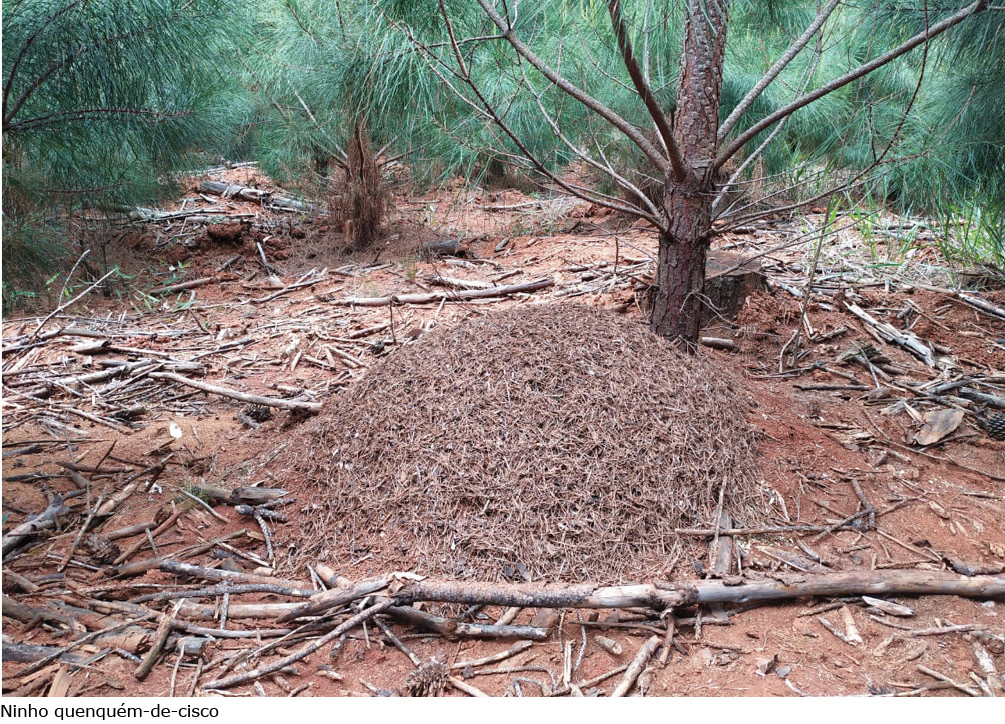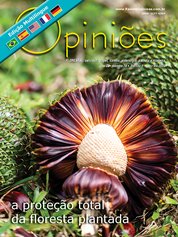Mariane Aparecida Nickele e Wilson Reis Filho
Consultora Funcema/Embrapa Florestas e Pesquisador da Epagri/Embrapa Florestas
OpCP70
As quenquéns em florestas plantadas: um problema subdimensionado
As formigas cortadeiras conhecidas como saúvas e quenquéns estão entre as principais pragas florestais no Brasil, podendo, senão controladas, inviabilizar economicamente a implantação de uma floresta. As quenquéns se dispersam através de revoadas de reprodutores, o que ocorre uma vez por ano durante a primavera, mas, além da revoada, podem também se dispersar por meio da migração, o que fazem com muita frequência, buscando locais mais favoráveis ao desenvolvimento das suas colônias.
As saúvas, por apresentarem ninhos maiores e mais vistosos devido à terra solta que depositam na superfície do solo, são mais estudadas e são motivo de maior preocupação do que as quenquéns, por atacarem as plantas em qualquer fase de desenvolvimento, principalmente em plantios de eucalipto.
No entanto, as quenquéns também apresentam grande potencial de danos, mas apenas em plantios iniciais, sendo que a área de forrageamento de uma colônia adulta pode alcançar um raio de até 80 metros e, com isso, pode atacar um número significativo de mudas recém-plantadas.

Há ocorrência de formigas cortadeiras em todo o território brasileiro, sendo mais raro encontrarem-se ninhos de saúvas em áreas com altitude acima de 800 metros, fator esse não limitante para a ocorrência de quenquéns. As quenquéns são mais frequentes que as saúvas, sendo possível encontrar áreas com ocorrência só de quenquéns, mas não é comum uma área com ocorrência apenas de saúvas. Os ninhos de algumas espécies de quenquéns, como Acromyrmex subterraneus, embora não sejam muito profundos, são subterrâneos e com terra solta na superfície do solo, podendo-se confundir com ninhos jovens de saúvas.
Para confirmar o gênero, no entanto, será necessário observar o número de espinhos no tórax das operárias, que são quatro ou cinco pares no caso das quenquéns, enquanto as saúvas apresentam apenas três pares. As quenquéns, dependendo da espécie, podem ainda construir ninhos superficiais cobertos com monte de cisco, como faz a espécie Acromyrmex crassispinus. Há também a espécie de quenquém Acromyrmex niger, que faz ninhos subterrâneos, mas sem terra solta na superfície do solo, o que dificulta o seu monitoramento.
É comum encontrar uma média de 35 ninhos de quenquém-de-cisco por hectare em plantios de pínus com a idade próxima aos três anos. Isso ocorre, mesmo em plantios onde foram realizados o combate pré e pós-plantio, quando uma grande quantidade de ninhos eram iniciais, os quais tem baixa atividade externa, tornando-se difícil de encontrá-los. Dessa forma, os ninhos podem chegar aos três anos de idade, quando já há reprodutores, e causar um aumento da infestação de formigas cortadeiras nas áreas adjacentes. Somente próximo aos quinze meses de idade é que os ninhos de quenquéns-de-cisco são mais fáceis de serem visualizados no campo, possibilitando o controle localizado.
É mais fácil monitorar uma área quanto à infestação de saúvas do que de quenquéns, pois todos os ninhos de saúvas podem ser encontrados desde a fase de ninho inicial, quando seu raio de ação ainda é pequeno. As espécies de quenquéns apresentam seus ninhos de forma variada, mas são bem menores que os de saúva e migram com frequência.
O combate às formigas cortadeiras está baseado na utilização de isca granulada que pode ser aplicada de modo localizado, quando são encontrados os ninhos, ou de maneira sistemática, distribuindo-se homogeneamente uma quantidade de isca na área. Há diferentes marcas comerciais de iscas granuladas no mercado, e há basicamente dois modos de apresentação, que são: a granel e acondicionada em saches de 5 ou 10 gramas. Para o controle de um ninho de quenquém-de-monte-de-cisco, são necessários apenas 5 gramas de isca granulada aplicada ao lado de uma das trilhas de forrageamento. Antes de colocar a isca, deve-se observar se a trilha é de forrageamento, pois é possível que uma ou mais trilhas estejam sendo usadas para transportar apenas cisco para a cobertura dos ninhos. No caso das quenquéns que fazem ninho com monte de terra solta e Acromyrmex niger, aplicam-se 5 gramas por trilha.
Se as atividades de combate às formigas cortadeiras forem realizadas de modo localizado, visando apenas ao controle dos ninhos de saúvas, a eficácia poderá não ser alcançada devido à infestação de quenquéns, que apresentam ninhos de difícil localização e sempre estarão numa densidade maior do que de saúvas. É por isso que a aplicação sistemática de iscas formicidas no período pré-plantio, muitas vezes, é crucial para o sucesso da implantação de um plantio florestal, mas é importante que essa atividade ocorra entre 15 e 30 dias antes do plantio. Se for realizado num período maior de 30 dias, pode ocorrer a migração de ninhos de quenquéns na área a ser plantada.
A implantação de uma floresta de eucalipto numa área de pastagem requer mais atenção com as formigas cortadeiras, pois, mesmo na ausência de saúvas, pode-se ter um ataque de quenquéns em até 70% das mudas nos primeiros 30 dias de plantio.
No entanto, os danos de quenquéns em eucalipto restringem-se aos primeiros meses após o plantio. A partir dos seis meses, não há mais a necessidade de realizar o combate às formigas nos locais de ocorrência só de quenquéns, ao contrário do que é recomendado nos plantios que há a ocorrência de saúvas, que precisam ser monitorados e controlados durante todo o ciclo florestal.
Em plantios de pínus, há uma situação que não há necessidade de realizar o controle sistemático no período pré-plantio: em áreas de reforma, cujo plantio anterior era pínus não desbastado, com pousio entre o corte raso e novo plantio de menos de seis meses, plantio ocorrendo no inverno, em locais distantes de áreas de matas nativas (APPs, Reserva Legal...) e quando a ocorrência for somente de quenquéns.
Além disso, observou-se a influência do manejo de plantas daninhas nos ataques das quenquéns, sendo que onde esse manejo é realizado por meio de roçadas há menos ataques de formigas nas plantas de interesse comercial, pois a roçada não elimina totalmente as plantas daninhas, que acabam servindo de recursos para o forrageamento das formigas, e, nesse caso, o combate pode ser realizado apenas no primeiro ano após o plantio.
Quando há uso de herbicidas, é necessário realizar o manejo de formigas, pelo menos enquanto houver o manejo de plantas daninhas (até o terceiro ou quarto ano após o plantio). As quenquéns não causam prejuízos em plantios adultos de pínus, assim não é necessário realizar o monitoramento e controle de quenquéns nessa fase. Todos os fatores que influenciam no manejo de formigas cortadeiras em plantios de eucalipto e pínus constam numa planilha eletrônica (Ferramenta computacional - Manejo Formigas) disponível no site da Embrapa Florestas. Essa ferramenta contém 16 recomendações diferentes em função de cada situação, visando orientar a tomada de decisão sobre o manejo adequado de formigas cortadeiras em cada etapa do plantio.





